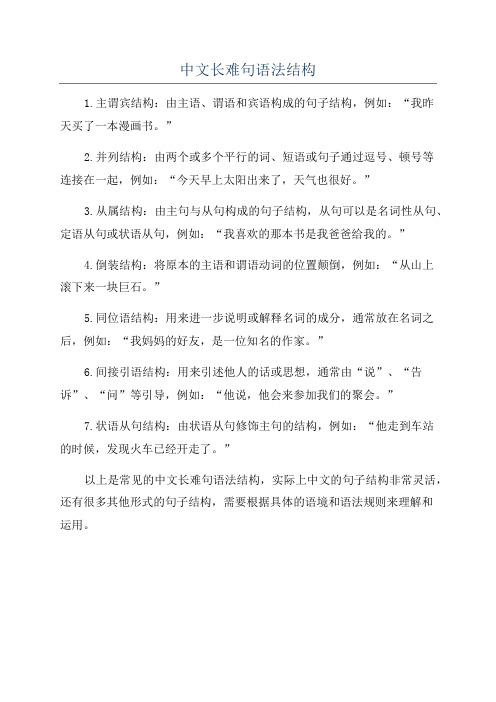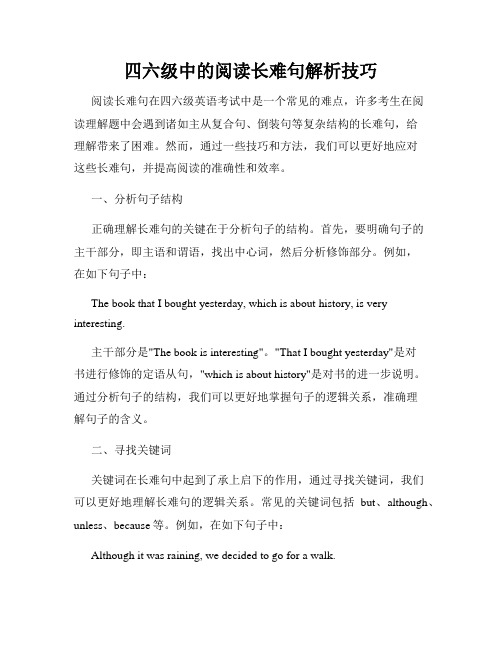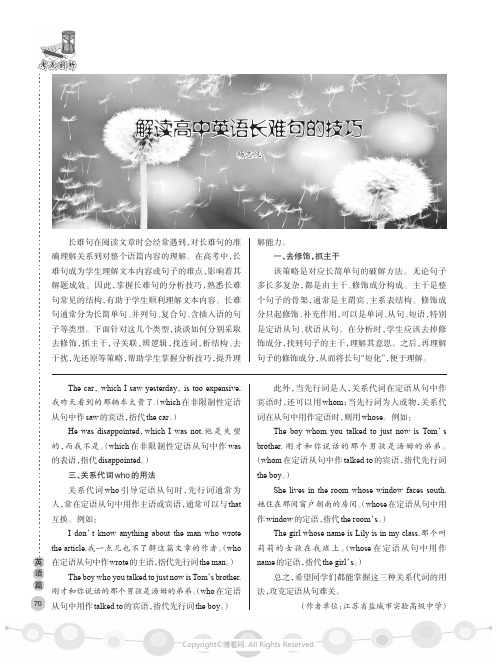简化结构、回补成分和还原句子——三步骤解析长难句
阅读长难句分析技巧

阅读长难句分析技巧阅读理解是考试中的一项重要内容,而长难句往往是让人们感到头疼的地方。
在阅读中遇到长难句时,我们需要一些技巧来解析句子的意思,帮助我们更好地理解文章。
本文将介绍一些阅读长难句的分析技巧,帮助读者们在考试中取得更好的成绩。
1. 理清句子结构长难句往往由多个分句组成,其中包含了各种从句、修饰语等。
首先,我们需要分析句子的结构,理清主干和从句之间的关系。
可以通过将句子拆解成独立的分句,然后逐一分析每个分句的结构和作用,最后再将这些分句组合起来理解整个句子的意思。
2. 注意逻辑关系词长难句中经常包含逻辑关系词,如因果关系、转折关系、并列关系等等。
对于含有逻辑关系词的长难句,我们应该特别关注这些词的作用,通过分析它们的语境来确定句子的逻辑关系,帮助我们更好地理解句子的意思。
3. 利用标点符号标点符号在句子中起到了分隔和标识语法结构的作用。
在阅读长难句时,我们需要注意标点符号的位置和作用。
特别是逗号、分号、冒号等,它们常常用来分隔不同的分句或者修饰语,帮助我们理清句子的结构。
4. 理解修饰语长难句中经常会有各种各样的修饰语,如形容词性的修饰语、副词性的修饰语、定语从句等。
我们在阅读时需要明确修饰语与被修饰语的关系,找出它们之间的联系。
可以通过找到修饰语的位置和作用,然后与它所修饰的词进行对应,帮助我们理解句子的意思。
5. 多读多练阅读长难句的能力需要通过大量的阅读和练习来提高。
我们可以选择一些经典的语法书籍或者高质量的阅读材料,多读一些复杂的句子,不断锻炼自己的理解能力。
同时,我们还可以做一些阅读理解的练习题,通过实际的操作来提高我们解析句子的能力。
通过以上的分析技巧,我们可以更好地应对考试中的长难句,提高我们的阅读理解能力。
希望读者们能够通过不断的练习和积累,掌握这些技巧,并在考试中取得好成绩。
阅读长难句不再成为你的难题,而成为你的优势。
中文长难句语法结构

中文长难句语法结构
1.主谓宾结构:由主语、谓语和宾语构成的句子结构,例如:“我昨
天买了一本漫画书。
”
2.并列结构:由两个或多个平行的词、短语或句子通过逗号、顿号等
连接在一起,例如:“今天早上太阳出来了,天气也很好。
”
3.从属结构:由主句与从句构成的句子结构,从句可以是名词性从句、定语从句或状语从句,例如:“我喜欢的那本书是我爸爸给我的。
”
4.倒装结构:将原本的主语和谓语动词的位置颠倒,例如:“从山上
滚下来一块巨石。
”
5.同位语结构:用来进一步说明或解释名词的成分,通常放在名词之后,例如:“我妈妈的好友,是一位知名的作家。
”
6.间接引语结构:用来引述他人的话或思想,通常由“说”、“告诉”、“问”等引导,例如:“他说,他会来参加我们的聚会。
”
7.状语从句结构:由状语从句修饰主句的结构,例如:“他走到车站
的时候,发现火车已经开走了。
”
以上是常见的中文长难句语法结构,实际上中文的句子结构非常灵活,还有很多其他形式的句子结构,需要根据具体的语境和语法规则来理解和
运用。
四六级中的阅读长难句解析技巧

四六级中的阅读长难句解析技巧阅读长难句在四六级英语考试中是一个常见的难点,许多考生在阅读理解题中会遇到诸如主从复合句、倒装句等复杂结构的长难句,给理解带来了困难。
然而,通过一些技巧和方法,我们可以更好地应对这些长难句,并提高阅读的准确性和效率。
一、分析句子结构正确理解长难句的关键在于分析句子的结构。
首先,要明确句子的主干部分,即主语和谓语,找出中心词,然后分析修饰部分。
例如,在如下句子中:The book that I bought yesterday, which is about history, is very interesting.主干部分是"The book is interesting"。
"That I bought yesterday"是对书进行修饰的定语从句,"which is about history"是对书的进一步说明。
通过分析句子的结构,我们可以更好地掌握句子的逻辑关系,准确理解句子的含义。
二、寻找关键词关键词在长难句中起到了承上启下的作用,通过寻找关键词,我们可以更好地理解长难句的逻辑关系。
常见的关键词包括but、although、unless、because等。
例如,在如下句子中:Although it was raining, we decided to go for a walk.关键词"although"暗示了前后两个分句之间的转折关系,帮助我们理解这个句子的含义。
三、弄清句子成分的逻辑关系在长难句中,句子成分之间的逻辑关系是理解整个句子的关键。
通过弄清句子成分的逻辑关系,我们可以准确地把握长难句的意义。
常见的逻辑关系包括因果关系、条件关系、让步关系等。
例如,在如下句子中:If you study hard, you will succeed.通过理解句子成分"if you study hard"和"you will succeed"之间的逻辑关系,我们可以准确地理解这个句子的意义。
掌握四六级阅读长难句的解析方法

掌握四六级阅读长难句的解析方法在掌握英语四六级阅读长难句的解析方法之前,首先需要理解什么是长难句。
长难句是指句子结构较复杂,包含多个从句或短语的句子。
这些句子较长,语法结构复杂,理解起来相对困难。
而掌握长难句的解析方法,可以帮助我们更有效地阅读、理解和分析文章。
本文将介绍几种常见的长难句解析方法。
一、分析句子结构长难句具有复杂的语法结构,因此分析句子结构是解析长难句的第一步。
首先,要找出句子的主语和谓语,并理解它们的关系。
接着,寻找从句和短语,并注意它们在整个句子中的作用。
最后,分析句子中的连接词,如连词、副词和关系词,它们在句子中起到连接不同成分的作用。
二、注意关系词的作用关系词是连接两个句子或短语的重要词汇,在理解长难句时起着关键的作用。
常见的关系词包括:that, which, who, whom, whose, where, when, why等。
这些关系词能够表明主从关系、定语从句、状语从句等。
三、分析句子的逻辑关系长难句中的逻辑关系对于整个句子的理解至关重要。
要注意分析句子中每个从句或短语与主语、谓语的逻辑关系。
例如,从句可能是一个原因、条件、目的、结果等。
理解这些逻辑关系有助于我们更好地把握文章的主旨和作者的观点。
四、使用上下文信息上下文信息对于理解长难句至关重要。
当遇到较难的句子时,我们可以通过查找上下文的相关信息来帮助理解。
注意关注上下文中的词汇、短语、句子和段落,以便更好地理解句子的含义。
五、划分句子成分划分句子成分有助于我们更好地理解长难句。
我们可以使用线条或箭头将句子分成不同的成分,如主语、谓语、宾语、定语从句、状语从句等。
通过这种方式,我们可以将句子分成更小的部分,以便更好地理解和分析。
六、学习常见的句型模式长难句往往包含一些常见的句型模式,例如倒装句、强调句、比较句、条件句等。
通过学习这些句型模式,我们可以更容易地理解句子的结构和含义。
记住常见的句型模式,并在阅读时识别并理解它们。
解读高中英语长难句的技巧

考点剖析The car,which I saw yesterday,is too expensive.我昨天看到的那辆车太贵了.(which在非限制性定语从句中作saw的宾语,指代the car。
)He was disappointed,which I was not.他是失望的,而我不是。
(which在非限制性定语从句中作was 的表语,指代disappointed。
)三、关系代词who的用法关系代词who引导定语从句时,先行词通常为人,常在定语从句中用作主语或宾语,通常可以与that 互换。
例如:I don’t know anything about the man who wrote the article.我一点儿也不了解这篇文章的作者。
(who 在定语从句中作wrote的主语,指代先行词the man。
)The boy who you talked to just now is Tom’s brother.刚才和你说话的那个男孩是汤姆的弟弟。
(who在定语从句中用作talked to的宾语,指代先行词the boy。
)此外,当先行词是人,关系代词在定语从句中作宾语时,还可以用whom;当先行词为人或物,关系代词在从句中用作定语时,则用whose。
例如:The boy whom you talked to just now is Tom’s brother.刚才和你说话的那个男孩是汤姆的弟弟。
(whom在定语从句中作talked to的宾语,指代先行词the boy。
)She lives in the room whose window faces south.她住在那间窗户朝南的房间。
(whose在定语从句中用作window的定语,指代the room’s。
)The girl whose name is Lily is in my class.那个叫莉莉的女孩在我班上。
(whose在定语从句中用作name的定语,指代the girl’s。
攻克长难句:化繁为简,找出主干

第 1 页 共 1 页 攻克长难句:化繁为简,找出主干在考研英语中,考生们会很熟悉一个名字,那就是长难句。
在整个考试中长难句无所不在,几乎充斥了整个考试,完型、阅读和翻译,所有的题型中都包含了众多长难句。
所以具备解决长难句的能力是每个考研学生要具备的基本能力。
今天,凯城王老师就详细和大家谈谈如何攻克考研英语长难句。
长难句顾名思义,不仅句子长,单词多,而且句子的结构复杂,有些甚至是层层嵌套,这些一系列的特征就让很多阅读能力平平的考生望而却步,所以要想解决长难句的问题,我们应该从了解西方人英语阅读的习惯入手,以及西方阅读习惯与我们的差异。
在中西方阅读习惯的中我们可以发现,困惑很多考生的长难句翻译问题,首先,要找到句子的主干,然后再去翻译句子的修饰部分,这样不仅能清晰地把握句子的意思,而且能够了解哪部分为修饰,哪部分可以省略不读,这样在紧张的考研考试中会节省更多的时间,提高做题的效率。
那么长难句该如何复习呢? 首先,长难句看不懂一般有两种情况: 第一,单词看不懂;这种情况没办法,只能背单词,不要求5500全部掌握,但高频单词一定要掌握。
第二,句子成分分析不出来。
对这种情况,我们的办法是八个字“化繁为简、找出主干”。
与汉语行文松散的结构不同,英语中每一个完整的句子都必须严格地遵守语法习惯,由“主语+谓语”这个基本结构构成。
因此在阅读长难句的时候,考生应该首先找到这个句子的主谓(宾)结构,其余的成分包括定语从句、宾语从句、同位语、插入语、定状补语等可以一概略过。
这个时候就剩下了一个干净简单的句子,这个主局一般都能够说明句子的大意。
在主句的基础上,考生在逐步地把句子的其他部分和主干句联系起来,分析并理清其中的关系,慢慢分析句子成分,哪些是主句,哪些是从句,包括分词的用法等等。
这个时候就该长句就会比较容易理解了。
其次,在阅读中理解长难句。
长难句部分作为考研英语阅读的难点应该专门下功夫攻克, 但是也不能把全部精力都放在长难句上。
英语长难句阅读解析、句型提炼和句子翻译

英语长难句阅读解析、句型提炼和句子翻译英语长难句是非常特别的学习资源,短小精炼、便捷高效,如果加以充分利用可以极大地促进对于英语句子的结构安排、语法关系、信息传递、逻辑表达和语言表述等方面的认知和应用,增强关于英语词汇、句子和段落等的理解和写作以至翻译的能力。
因此,我们应该在一段时间内进行集中强化训练,把长难句作为典型的句子进行结构解析,句型提炼和句子翻译,进而增强英语综合运用能力。
下面试对长难句(1)进行结构解析、句型和句子翻译。
一、原句:Any evaluation system in which the mere number of a researcher's publications increases his or her score creates a strong disincentive to pursue risky and potentially groundbreaking work, because it takes years to create a new approach in a new experimental context, during which no publications should be expected.二、解析:1. 简化结构:Any evaluation system …creates a strong disincentive …, …. 简化的结构是简单句主谓宾结构,主语是system,any evaluation 是主语的定语,谓语是creates,宾语是disincentive。
2. 回补成分:2.1 Any evaluation system …creates a strong disincentive to pursuerisky and potentially groundbreaking work, …, …. 回补后的成分是动词不定式短语to pursue risky and potentially groundbreaking work作disincentive后置定语,其中risky and potentially groundbreaking是并列定语修饰动词pursue的宾语work。
长难句做题步骤

长难句做题步骤
长难句做题步骤主要包括以下几个方面:
1. 仔细阅读句子:首先,要仔细阅读整个句子,理解句子的意思和结构。
注意句子中的主谓宾关系、修饰成分和连接词等。
2. 分析句子结构:在理解句子意思的基础上,分析句子的结构,找出句子的主干和从句等成分。
长难句通常包含主从复合句、插入语、并列关系等结构。
3. 确定句子的主要信息:根据句子的结构和语境,确定句子的主要信息。
找出句子中所涉及的主题、观点或事件等。
4. 理解句子的修饰成分:长难句中常常有大量的修饰成分,如形容词、副词、介词短语等。
要仔细理解这些修饰成分与主要信息之间的关系,弄清它们在句子中的作用和修饰对象。
5. 确定句子的逻辑关系:长难句中的各个成分往往存在复杂的逻辑关系,包括因果关系、转折关系、并列关系等。
要通过分析句子的语境,确定这些逻辑关系,以便更好地理解句子的意义。
6. 理解句子的语法结构:长难句中的语法结构往往较为复杂,包括主谓宾结构、
从句结构、并列结构等。
要仔细分析句子的语法结构,包括动词的时态、语态、语气等,以确保对句子的理解准确无误。
7. 逐词解释句子中的难点词汇:长难句中可能存在一些难以理解的词汇,如生僻词、专业术语等。
要逐词解释这些难点词汇,确保对句子的整体理解正确。
8. 总结句子的主要含义:在完成以上步骤后,对整个句子进行总结,确定句子的主要含义和观点。
对于有争议的问题,要慎重,同时考虑多个可能的解释。
通过以上步骤,我们可以更好地理解和分析长难句,从而准确回答相关的问题。
在解答题目时,我们应该遵循清晰、准确、逻辑严密的原则,以确保回答的准确无误。
- 1、下载文档前请自行甄别文档内容的完整性,平台不提供额外的编辑、内容补充、找答案等附加服务。
- 2、"仅部分预览"的文档,不可在线预览部分如存在完整性等问题,可反馈申请退款(可完整预览的文档不适用该条件!)。
- 3、如文档侵犯您的权益,请联系客服反馈,我们会尽快为您处理(人工客服工作时间:9:00-18:30)。
本人一直提倡利用简化结构、回补成分和还原句子三个步骤来解析长难句,其意义在于通过简化、回补和还原的过程,可以快速准确锁定主谓结构,明确语法关系,培养语感,抓住句子的核心并理解句子的意义。
下面继续挑选五个句子进行解析,供英语爱好者参考。
第一句原句:To figure out how much power these devices are using Callie Babbitt and her colleagues at the Rochester Institute of Technology in New York tracked the environmental costs for each product throughout its life — from when its minerals are mined to when we stop using the device.解析:1. 简化结构:… Callie Babbitt and her colleagues … tracked the environmental costs … —….简化后的句子呈现简单句主谓宾结构,Callie Babbitt and her colleagues是并列主语,tracked 是谓语,the environmental costs是宾语。
2. 回补成分:2.1 To figure out how much power these devices are using Callie Babbitt and her colleagues… tracked the environmental costs… —….按序回补句子成分,动词不定式短语to figure out … 是目的状语修饰谓语tracked,由疑问副词how引导的从句how much power these devices are using是动词词组figure out的宾语从句。
2.2 To figure out how much power these devices are using Callie Babbitt and her colleagues at the Rochester Institute of Technology in New Yorktracked the environmental costs for each product throughout its life —….继续回补句子成分,介词短语at the Rochester Institute of Technology in New York作后置定语修饰并列主语Callie Babbitt and her colleagues,介词短语for each product throughout its life作后置定语修饰costs。
2.3 To figure out how much power these devices are using Callie Babbitt and her colleagues at the Rochester Institute of Technology in New York tracked the environmental costs for each product throughout its life — from when its minerals are mined to when we stop using the device.最后回补所有成分,还原句子,破折号—是以标点,非语言手段连接前后句子成分,旨在对前述内容作进一步的扩展,即解释说明。
介词词组from…to各自接由疑问副词when引导的从句作宾语。
3. 小结:本句比较长,但并不太复杂,需要注意的是本句的平衡处理的非常好,句首是较长的动词不定式接宾语从句的状语,主句的主语和谓语分隔较远,破折号引导的介词词组接宾语从句处于句尾,层次分明,平衡得当。
第二句原句:The show which ran from 1993-2000 followed a teenage boy whose curiosity about life leads himinto some hilarious adventures while growing up alongside his friends and family.解析:1. 简化结构:The show … followed a teenage boy ….简化后的句子为简单句, The show是主语,followed是谓语,a teenage boy是宾语。
2. 回补成分:2.1 The show which ran from 1993-2000 followed a teenage boy …回补后的成分是主语the show的非限定性定语,将主谓成分分隔开,这种结构往往造成信息传递障碍,尤其是分隔部分比较长的情况下。
2.2 The show which ran from 1993-2000 followed a teenage boy whose curiosity about life leadshim into some hilarious adventures ….继续回补的成分,是主句宾语的定语从句,关系代词whose在从句中作主语curiosity的定语,同时引导定语从句,谓语是leads,介词短语about life作后置定语修饰curiosity,介词短语into some hilarious adventures作从句的状语修饰谓语动词lead。
2.3 The show which ran from 1993-2000 followed a teenage boy whose curiosity about life leadshim into some hilarious adventures while growing up alongside his friends and family.最后回补成分,还原句子,由关联词while引导现在分词短语growing …做状语修饰,修饰定语从句中的谓语lead,介词短语alongside …作现在分词growing的状语。
需要注意的是,根据上下文,现在分词growing的逻辑主语是其所在的定语从句中的宾语him,因逻辑关系明确清晰因而采用while growing…这种省略形式,可以还原成表示时间的状语从句:while he grew up alongside his friends and family。
3. 小结:本句虽然不算长,但比较复杂,有分隔成分和省略成分,信息传递不够流畅,给理解造成一定的困难。
第三句:原句:That might mean either developing a uniform way to mark videos and images showing when andwho they were made by or abandoning phone calls altogether and moving towards data-baxxxxsed communications — using apps like FaceTime or WhatsApp which can be tied to your identity.解析:1. 简化结构:That might mean either developing … or abandoning … and moving … —….简化后的句子为简单句,主谓宾结构清晰明了,主语是代词That,谓语是情态助动词might和动词mean,宾语是三个动名词developing,abandoning和moving,是并列宾语,副词either作状语并和连词or形成either…or结构。
本句因并列成分多,为简明计,把动名词所带的宾语省略。
2. 回补成分:2.1 That might mean either developing a uniform way to mark videos and images … or abandoning phone calls altogether and moving towards data-baxxxxsed communications —….回补后的成分包括,第一个并列宾语developing所带的宾语a uniform way to mark videos and images,其中动词不定式短语to mark videos and images作定语修饰way,第二个并列宾语abandoning所带的phone calls作宾语和副词altogether作状语,第三个并列宾语moving所带的towards data-baxxxxsed communications作状语。
2.2 That might mean either developing a uniform way to mark videos and images showing when and who they were made by or abandoning phone calls altogether and moving towards data-baxxxxsed communications —….继续回补后的成分是现在分词showing引导的短语作状语修饰动词不定式to mark,同时接由疑问副词when和关系代词who引导的宾语从句。
2.3That might mean either developing a uniform way to mark videos and images showing when and who they were made by or abandoning phone calls altogether and moving towards data-baxxxxsed communications — using apps like FaceTime or WhatsApp which can be tied to your identity.最后回补还原的句子是由破折号—引导的现在分词短语作同位语修饰communications,其中,由which引导的非限定性定语从句修饰前面两个专有名词FaceTime和WhatsApp。
3. 小结:本句比较长且复杂,但更主要的是有些成分的修饰关系比较难确定,需要根据逻辑关系进行判断,如,showing是修饰developing还是修饰to mark需要仔细琢磨。
